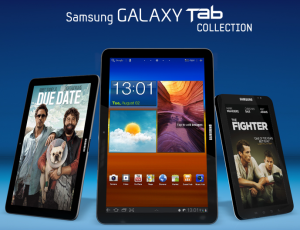 Samsung was the fist to show that Android could succeed on a tablet when they launched the infamous original Galaxy Tab back in October of 2010. This was a 7″ device and was devised long before the tablet-specific Android 3.0 Honeycomb build was available. Despite relying on a customized version of Android which was meant for phones, the original Samsung Galaxy Tab 7 succeed and paved the way for future Android tablets.
Samsung was the fist to show that Android could succeed on a tablet when they launched the infamous original Galaxy Tab back in October of 2010. This was a 7″ device and was devised long before the tablet-specific Android 3.0 Honeycomb build was available. Despite relying on a customized version of Android which was meant for phones, the original Samsung Galaxy Tab 7 succeed and paved the way for future Android tablets.
Eager to run with that success, and now armed with the tablet-oriented Honeycomb, Samsung began to add various sizes to the Galaxy Tab line. Now that Android 4.0 Ice Cream Sandwich has been unleashed, Samsung faces the problem of bringing their current devices up to date with the latest software. However, Samsung is going about it in a dubious way — they’re adding new models which seem to usurp older models, but the specs and designs hardly differentiate the new products. Here’s the current rundown of Galaxy Tab devices (sorted by series chronology):
- Galaxy Tab 7
- Galaxy Tab 8.9
- Galaxy Tab 10.1
- Galaxy Tab 7.7
- Galaxy Tab 7 Plus
- Galaxy Tab 2 (7.0)
- Galaxy Tab 2 (10.1)
Furthermore, Samsung has just recently announced the Galaxy Note 10.1 which doesn’t bear the ‘Tab’ part of the name. The confusing part is that the Galaxy Note 10.1 sounds like it should be equivalent to the Galaxy Tab 10.1 aside from the S Pen stylus functionality, but instead it is actually more like the Galaxy Tab 2 (10.1) (which again, is hardly distinguishable from the original Galaxy Tab 10.1). So at this point, Samsung has managed to confusingly mesh the Galaxy Note series with the Galaxy Tab series.
Let’s not forget that these devices all look frighteningly similar to one another, given the same size class.
And this is all fine coming from someone like myself whose job is to track this stuff, but to your everyday consumer, this is sure to be a mess. It’s going to impact customers when they search for these products online, when they try to find reliable reviews and specifications, when they go to purchase the products, and even when searching for after-purchase support.











Samsung’s market strategy goes from bad to worse…
The original Galaxy Tab did have a good opportunity to give iPad a row but Samsung wasted it by marking a ridiculous high price. Apparently Samsung did not learn from this and continue to lose the GTab fans like myself…